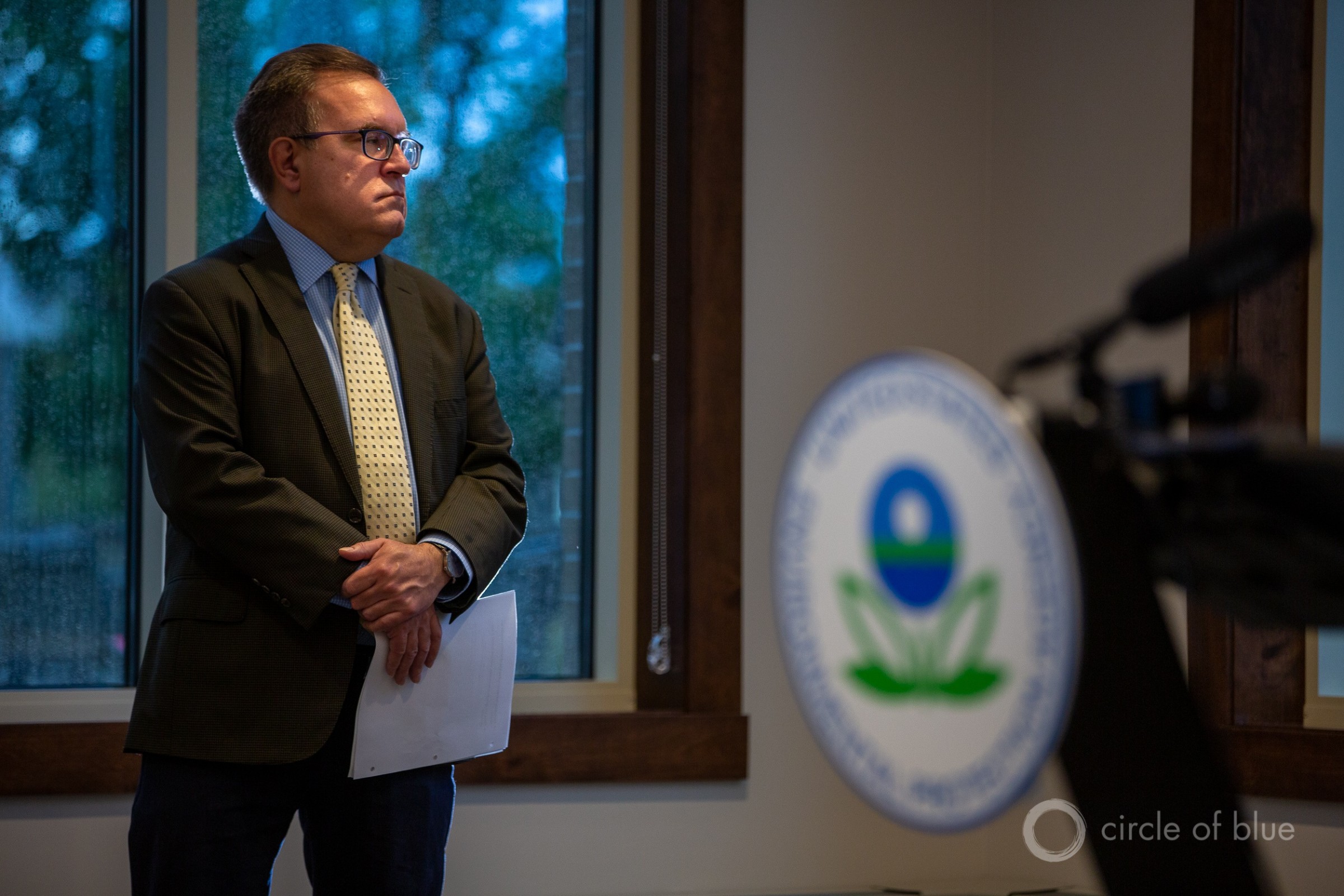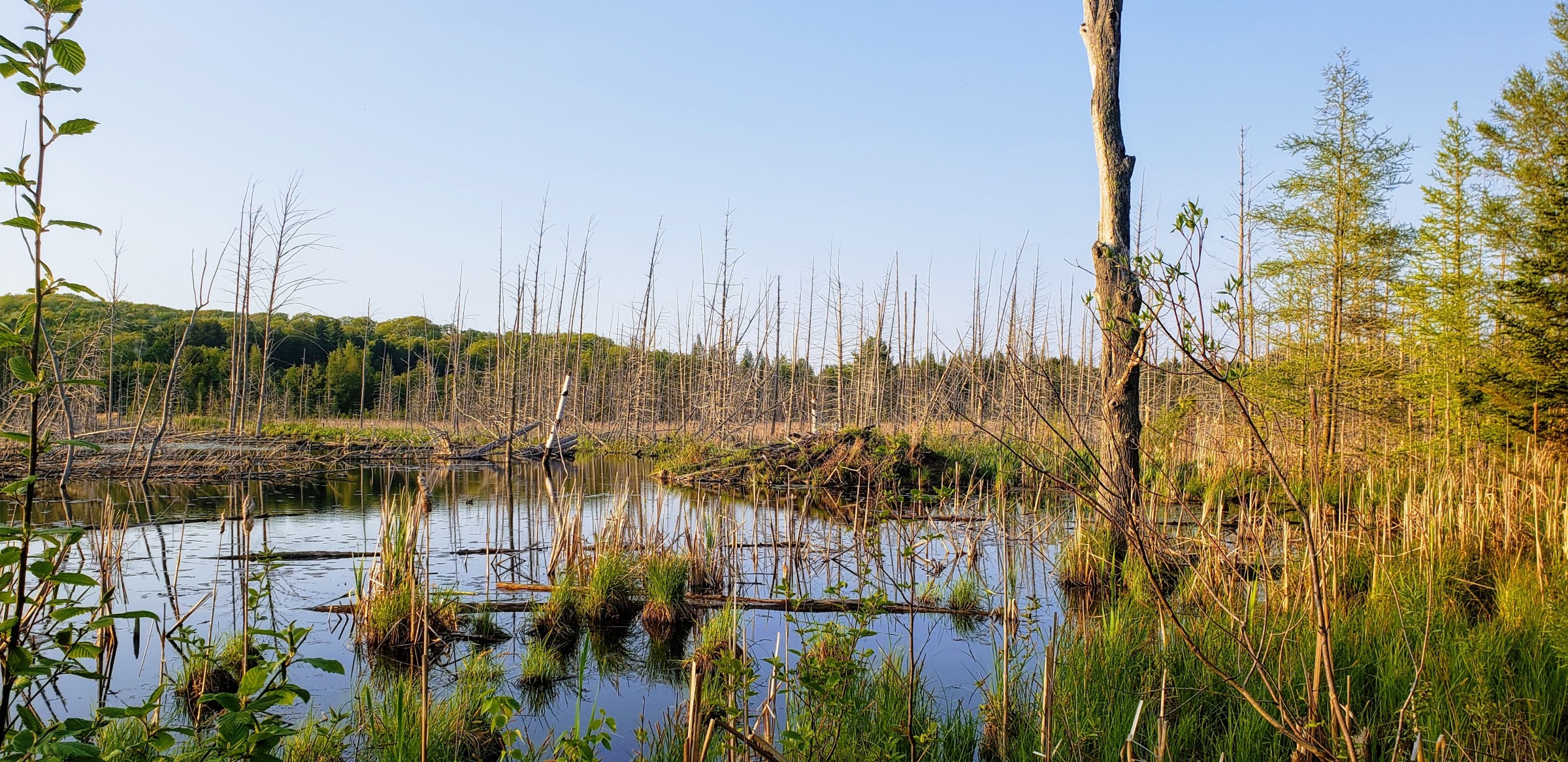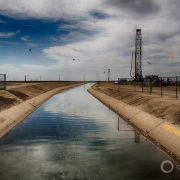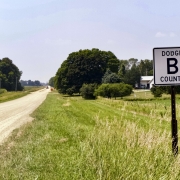What Has the Trump Administration Meant for Water?
By narrowing or repealing federal rules, the Trump administration has prioritized big business and reduced pollution protection for waterways.

Andrew Wheeler, administrator of the U.S. Environmental Protection Agency, prepares to speak at an event in Traverse City, Michigan, on September 30, 2020. Photo © J. Carl Ganter / Circle of Blue
By Brett Walton, Circle of Blue
In the closing minutes of the first presidential debate of this election cycle, the line of questioning turned, surprisingly, to climate change.
The moderator, Chris Wallace of Fox News, had not listed climate as one of the topics he planned to bring up. But then, nearly seventy-five minutes into the event, he did.
The fires burning in the American West were the prompt. Turning to the president, Wallace asked Trump what he believed about climate science and what he would do in the next four years to confront carbon pollution. Trump, at first, demurred.
“I want crystal clean water and air,” Trump responded. Then he pivoted to a familiar talking point: railing against cluttered forests as the cause of wildfires in California and other western states.
The initial line — the desire for crystal clean water — is one that the president repeats frequently, even dating to his 2016 presidential campaign. Immaculate water, he has also said. Clear water. Beautiful water. But the focus on appearances is superficial, according to a number of water advocates and analysts. Revisions to environmental rules that the administration has pursued during the first term of the Trump presidency will be detrimental to the nation’s waters, they said.
“President Trump loves to say that he wants crystal clear water,” Bob Irvin, president and chief executive of the conservation group American Rivers, told Circle of Blue. “But his administration has adopted policies that will result in dirtier water across the country.”
Irvin, an environmental lawyer by training, has worked in Washington D.C. for more than three decades, starting out as a trial attorney in the Justice Department during the Reagan administration. He was senior counsel for fish and wildlife for the Senate Committee on Environment and Public Works. He worked for conservation organizations like the World Wildlife Fund and the National Wildlife Federation. His career has spanned Republican and Democratic administrations and there was always at least some common ground for environmental priorities, he reflected.
Not during the Trump administration, though. Irvin could not name any beneficial administration policy for waterways. “It is stunning for me to say that,” he said.
Others interviewed for this story were not as absolute, but they echoed, to varying degrees, Irvin’s thoughts: “This administration has been unrelentingly hostile to the idea of conservation and environmental protection, and has been single-minded in its determination to undermine that protection.”
What Role for Water?
There was hope, at least in the beginning, for common ground. Trump entered office proclaiming himself a builder and a dealmaker and quipped in interviews about his desire for crystal clear water.
A long-term commitment to revive America’s corroded water distribution systems, buckling roads, outdated electric grids, inadequate broadband networks, and unstable bridges seemed to be a potential point of bipartisan agreement.
Instead, the outcome was marginal increases to existing programs and a punchline.
Experts and lobbyists swarmed to D.C. to champion infrastructure investment. Think tanks held policy briefings. But the president could not cajole enough Senate Republicans to compromise with Democrats, who were putting substantial amounts of funding on the table: multibillion-dollar increases to federal water infrastructure lending programs, nationwide lead service line replacements, investment in the next generation of water recycling systems.
When no grand deal was reached, the process repeated. And repeated. Soon, policy wonks began joking that “Every week is infrastructure week.”
Failure to secure a big win for infrastructure was surpassed by an agenda to undo environmental protections.
First under Scott Pruitt and currently led by Andrew Wheeler, who lobbied for fossil fuel industries he now regulates, the U.S. Environmental Protection Agency took the reins in the administration’s plan to weaken federal authority and relinquish power to the states.
Like his boss, Wheeler made public statements that lifted water to a place of prominence.
“My frustration with the current dialogue around environmental issues is that water issues often take a backseat,” Wheeler told the audience at the Wilson Center on March 20, 2019, in an event to mark World Water Day. “It’s time to change that.”
And yet, many critics and analysts say that the administration did not change that. Regulatory rollbacks not only at the EPA but from the Army Corps of Engineers, Bureau of Reclamation, and the Department of Energy leave the country’s waters more vulnerable to pollution and development, they say. States, which are enduring budget cuts to their environmental units, are not in a position to be a backstop, argues Eric Schaeffer, executive director of the Environmental Integrity Project.
“The assumption that states are going to come in and fill the gap is not warranted,” Schaeffer told Circle of Blue. Schaeffer was the director of EPA’s Office of Civil Enforcement from 1997 to 2002. His group released a study showing that 31 states reduced funding for state pollution control agencies from 2008 to 2018. “When EPA leaves the field, it leaves a lot of work undone,” he said.
The list of places where EPA has left the field or stepped back from it is long. The administration gave coal power plants more time to close unlined waste pits and relaxed standards for pollutants in power plant wastewater that is discharged to rivers and lakes. It narrowed the scope of state reviews of pollution impacts under the Clean Water Act. It withdrew a proposal that would have required mining companies to provide more financial assurance that they could clean up future water contamination. Reversing an Obama-era decision, it decided not to regulate perchlorate in drinking water. Draft rules for lead in drinking water appear to give utilities more time to replace lead service lines.
The U.S. Forest Service, for its part, overturned an Obama-era prohibition on mining leases in about 234,000 acres of Superior National Forest in northern Minnesota. The administration is proceeding with an environmental review of the contested Twin Metals mine, a proposed copper-nickel mine that would be located in the national forest some five miles from Boundary Waters Canoe Area Wilderness.
The Bureau of Reclamation, meanwhile, has sought to increase the height of Shasta Dam over the objections of the state of California and the Winnemem Wintu tribe, which do not want higher waters to submerge salmon habitat and cultural sites along the McCloud River. And the Bureau is carrying out an executive order to maximize water exports from the Sacramento-San Joaquin delta.
Laura Ziemer, the senior counsel and water policy advisor for Trout Unlimited, said that there is a lot of opportunity for the Bureau of Reclamation to invest in drought and climate preparedness in the western states through certain forms of natural water storage and irrigation efficiency. But projects like the Shasta Dam raise are not that.
“We’ve been asking Reclamation to promote that kind of investment through its WaterSmart program, and to date it has declined to do that,” Ziemer said, adding that the Trump administration is “looking in the rearview mirror and investing in water solutions from the past that have already proven to be unsustainable and not cost effective.”
Rewriting WOTUS
Out of all these deregulatory actions, one stood out. Most people interviewed for this story singled out the administration’s changes to the scope of the Clean Water Act — the definition of what counts as a water of the United States, or WOTUS — as the most damaging policy for water.
“It’s going to have consequences that are irreversible and far-reaching,” Kyla Bennett, New England director and science policy director at Public Employees for Environmental Responsibility, told Circle of Blue.

Wetlands in Sleeping Bear Dunes National Lakeshore. Photo © Laura Herd/Circle of Blue
Written by the EPA and Army Corps, the WOTUS rule reduces protections for wetlands and ephemeral streams that only flow after rainfall. Agency staff used national hydrological datasets to calculate that as many as half of the nation’s wetlands and 18 percent of streams would be excluded under the new rule. That means developers will not have to seek permits to fill in wetlands and stream segments that formerly had protection. It also means that requirements to minimize damage and offset unavoidable impacts by restoring wetlands elsewhere have been stricken.
Ziemer noted that western rivers are particularly vulnerable to the removal of protections for ephemeral streams.
“With water scarcity, drought resilience, and climate change resilience in these western landscapes, the permanent protection of that hydrologic function of these high-order streams is really key to the larger river basins maintaining their function, not only their drought resilience but reducing the risk of floods downstream,” Ziemer told Circle of Blue.
Watersheds that are connected from headwater channels to floodplains absorb high flows and retain that water through drought periods. “If we allow all of our hydrologic function to be paved over, we are going to expose ourselves to both flood and drought risk moving forward,” Ziemer said.
The EPA press office declined requests from Circle of Blue for interviews with Wheeler and David Ross, head of the Office of Water. It is the agency’s position that no existing map depicts accurately the boundaries of federal regulatory authority under the Clean Water Act. Several federal agencies are now working to publish such a guidepost.
Tipping the Balance of Power
What is the effect of this overhaul? In most cases, it is too early to say. Narrowing the scope of the Clean Water Act took effect this June for every state but Colorado. “It takes a while between the time you push the lever on a new policy or decision and the time the impacts show up in water quality,” Schaeffer said.
The administration touts other steps it has taken to secure the nation’s water: a national plan to coordinate the reuse of water, orders to speed up reviews and permitting of things like the management plan for federally managed dams on the Columbia River, and formalizing a water “subcabinet” of department heads who will coordinate policy, a determination that it will regulate two toxic PFAS substances in drinking water. FEMA, to the pleasure of green groups, also quietly advanced new guidance that allows greater use of federal flood prevention funds for natural infrastructure such as wetlands.
In general, the administration’s rules have tipped the balance of power to users of water: mining companies, energy developers, farmers, homebuilders. Even as it moves to regulate two PFAS in drinking water, the EPA is allowing the chemical industry to produce and sell new PFAS substances.
Among the president’s most ardent supporters is the American Farm Bureau Federation. Don Parrish, senior director of regulatory relations for the Farm Bureau, told Circle of Blue that the administration has assisted in three ways: collaborating with states on nutrient pollution, encouraging market-based systems for trading pollution credits, and simply listening to farm groups.
“One of our biggest priorities coming into this administration was a more realistic definition of waters of the United States,” Parrish told Circle of Blue. Narrowing the scope of the Clean Water Act accomplished that, Parrish said, though the Farm Bureau did not get everything it wanted in the revised rule.
The Utility Water Act Group, a coalition of energy utilities and industry groups that sued to overturn Obama-era coal ash regulations and to support the Trump administration’s environmental policies, declined to comment for this story.
It’s not just the policies that have drawn ire. The Trump administration has sought to transform the process by which those decisions are made: by sidelining scientific evidence and shrinking the environmental review process.
According to a survey of federal scientists, political appointees in the Trump administration raised barriers to using science in policy decisions. More than 4,200 federal scientists responded to the survey, which was conducted in 2018 by the Union of Concerned Scientists and Iowa State University. Half of respondents agreed or strongly agreed that political considerations outweighed scientific conclusions.
“This administration is completely anti-science,” Bennett said. “They’re hostile to any science that gets in their way.” PEER has filed a scientific integrity complaint against the National Oceanic and Atmospheric Administration for not using its own scientists’ data showing that fishing lines are driving the North Atlantic right whale to extinction.
Trump himself has appeared to influence particular rules. In several public appearances the president complained about the difficulty of washing his hair with low-flow showerheads. “You go into a new home, you turn on the faucet — no water comes out,” Trump said in remarks on August 6, 2020, at a Whirlpool Corporation manufacturing plant in Ohio that makes washing machines. “You turn on the shower — if you’re like me, you can’t wash your beautiful hair properly.”
A week later, the Department of Energy proposed to revise federal efficiency standards for showerheads. The current definition requires that the entire showerhead unit — the flow of each individual nozzle added together — not exceed 2.5 gallons per minute. The new definition would apply that standard to each nozzle individually. That means higher flows in aggregate, because each nozzle could spray 2.5 gallons per minute.
In comments submitted to the DOE, the International Association of Plumbing and Mechanical Officials, a voice for the plumbing industry, objected to the proposal because it would contradict current plumbing trends. It would be detrimental to water conservation, result in plumbing systems with too much spare capacity, imperil water quality in buildings, and waste energy. The revision, the group also argued, threatens the international acceptance of American plumbing standards, which could hurt sales of American plumbing products abroad.
The legacy of these four years is still being written. The administration’s policy changes have fared poorly in court. Many have been overturned because of procedural missteps and hastily written justifications. Other rules like the definition of waters of the United States are in the early stages of litigation. The election, too, will determine whether the administration has another four years to achieve its aims.
Brett writes about agriculture, energy, infrastructure, and the politics and economics of water in the United States. He also writes the Federal Water Tap, Circle of Blue’s weekly digest of U.S. government water news. He is the winner of two Society of Environmental Journalists reporting awards, one of the top honors in American environmental journalism: first place for explanatory reporting for a series on septic system pollution in the United States(2016) and third place for beat reporting in a small market (2014). He received the Sierra Club’s Distinguished Service Award in 2018. Brett lives in Seattle, where he hikes the mountains and bakes pies. Contact Brett Walton











Leave a Reply
Want to join the discussion?Feel free to contribute!